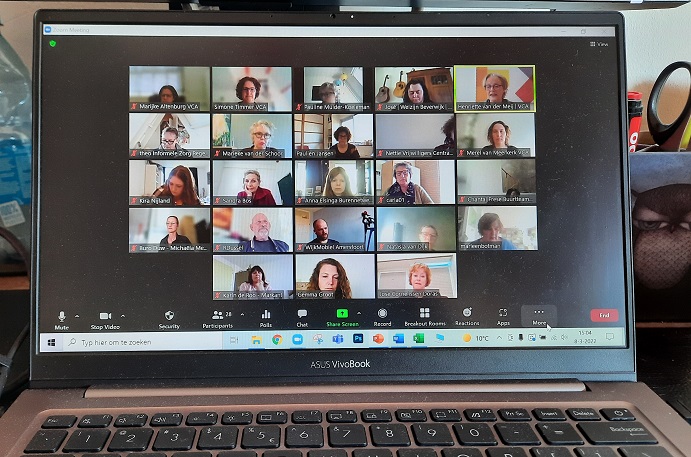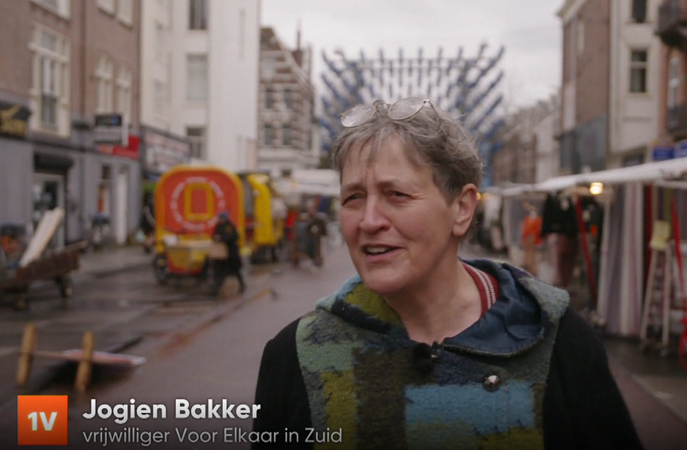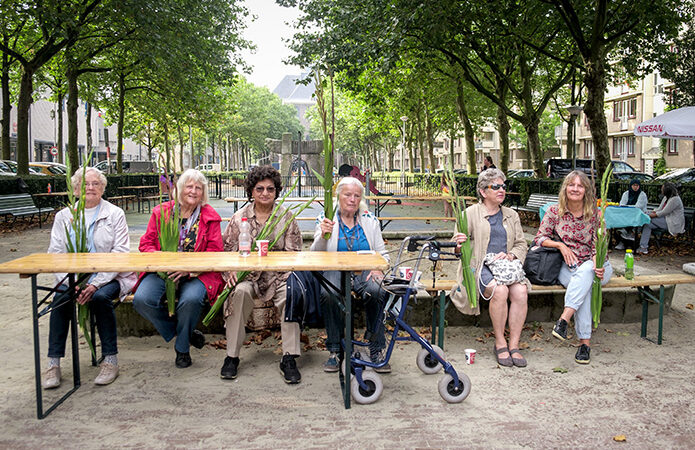Volunteers have been given more tasks in recent years. But while the workload increases, they do not always set their boundaries. Jogien can relate to this. She increasingly helps out as the elderly man with dementia, for whom she does shopping, requires more care. Now on EenVandaag.
Search for solutions for overwhelmed volunteers

On March 8th, we will explore and search for solutions for the statement: The expectations of voluntary involvement in informal care are (too) high. Volunteers become overwhelmed and drop out. We will be digitally sitting at the table with volunteer coordinators, managers, home care workers, volunteers, neighborhood team members, a municipal official, and a student. And we will discuss the current situation, our concerns for the future, and what possible solutions there are.
Who determines the boundaries of volunteering?
Due to budget cuts in healthcare, volunteers are taking over tasks that were previously done by professionals. Organizations are carefully assessing which tasks can also be done by a volunteer, as they do not want to disappoint people with problems. Where formal care ends, volunteer work continues, and we see volunteers taking on more responsibilities. This is a reaction to what is happening in formal care. The shortages in healthcare remain invisible as long as we keep supporting and patching up this system together.
People with complex issues are staying at home longer with less care because outpatient care has decreased with the introduction of Neighborhood Teams. Can this be solved by using volunteers? As a formal care provider, you must include in the tender which tasks clients can be supported with by a volunteer. This is not a choice, it is a boundary set by the municipality as the contractor.
There is a prevailing idea among contractors that volunteers are easy to find. And that the volunteer will continue the work for at least a year. Therefore, the assumption is that the costs for outpatient support can be reduced. Coordinating volunteers is much more labor-intensive than the municipality thinks, especially in areas where it really needs to happen, such as shopping and transportation. Volunteer coordinators have a very important task to find, equip, and guide volunteers. It is not free. But informal care is receiving less and less money to do this.
A participant:“I am concerned about the overload of volunteers, as they will eventually drop out because too much is being asked of them. They are not trained to provide professional care, become frustrated because they want to help but are unable to. The person in need then runs the risk of being overlooked because the professionals do not take on the care or do so too late.”Another participant:“The help requests we receive are becoming more complex. Many volunteers do not want to take on these more challenging requests. And when they do, they are more likely to quit volunteering sooner. For most people, volunteering should also be enjoyable, especially when it involves simple neighborly assistance rather than disguised care.”
Reciprocity is the impact of volunteering
Where then is that boundary? Many participants say it lies in household tasks and personal care. Tasks that are on the boundary include helping put on socks and shoes to go outside. Or doing a small amount of dishes when you come over for coffee. A boundary is also helping someone who is very despondent. Someone who can’t give anything back.
We hear that volunteers who are used for an easy task, such as running an errand, taking someone to the hospital, or having coffee together for companionship, are confronted with many more problems of the resident. A dirty house, a physical limitation, mental vulnerability.
A participant in the meeting says:“When you deploy a volunteer for a trip to the hospital and the resident lives on the third floor and cannot independently go down the stairs, something has gone seriously wrong. The volunteer manages, with great effort, to help someone down the stairs and get to the hospital on time. Volunteers are not asked to do this work, but are confronted with it. That’s when the line is quickly crossed.”Another talks about the collaboration with formal care:“We are not a free transportation organization. Otherwise, volunteering loses its uniqueness; we deploy volunteers for a ride and a chat. Volunteering involves a high degree of reciprocity that provides positive energy. A trip to the hospital with a chat and a cup of coffee afterwards creates a good feeling for both parties.”En:“As a coordinator, I often notice that there are more requests for help than volunteers I can deploy. For urgent assistance requests, we then rely on volunteers who may be able to help out temporarily, but deep down I know they are already doing more than enough and may not dare to say no.”
Say no more often
So, informal care organizations are receiving more and more requests from people facing a variety of issues: mental health problems, poverty, loneliness, addiction, and living in unsanitary conditions. Sometimes they ask for a bit of help, sometimes there is no help available for such residents at all. Additionally, there are often more requests coming in than there are volunteers available.
A participant of the meeting:“We were founded as an independent buddy organization and deploy volunteers for friendly contact, from person to person. That is our intention. That is why we exist. Formal care organizations call on us and see us as an extension of their work. I receive files from people that I am not interested in. I do not read them. We are not caregivers, and we do not respond to requests for help.”Another participant:“The boundary lies where you ask the volunteer for it. Clear tasks and expectations to which a volunteer says yes or no. When an organization starts shifting tasks and expectations, it is time to involve the people who perform the work for you in those developments. Ask them if they still want to do the changing work.”En:“As a volunteer coordinator, you must remain very alert. When the questions you receive become more complex, you are inclined to search for a solution. You do not want to leave an Amsterdammer out in the cold. On the other hand, you have the care for your volunteers. That is highly valued. Just like safeguarding our own objectives and right to exist.”
Solutions that we as volunteer organizations can implement
- Making transparent what a successful match/the deployment of a volunteer at work costs for the volunteer organization.
- Making visible the impact of our care, in numbers and stories from Amsterdammers who benefit from our volunteers.
- As a volunteer coordinator, saying no to complex requests for help, even if it is not appreciated.
- Saying no is something you have to learn.
- You can ask the care recipient or the referrer: Why is this a fun task for a volunteer? Would you want to do it yourself as volunteer work?
- Put on paper when to use volunteers and when not. This provides clarity internally and externally.
- Make rules of conduct for volunteers known to clients as well.
- Guide volunteers well while also protecting them from themselves to prevent them from crossing their own boundaries and the boundaries within volunteering work.
- Clear job profiles to recruit volunteers and set clear expectations.
- Conducting good intake interviews with volunteers, discussing mutual expectations.
- Pairing a new and ‘old’ volunteer to learn the boundaries of the work in practice.
- Listen to volunteers, what do they encounter in practice?
- Let volunteers determine and contribute ideas on what needs to be done. This may result in diversity in tasks, but isn’t that the essence of volunteers? Acknowledge their autonomy.
- What we don’t want: more schools and training volunteers to professionalize them. Equip, don’t shift towards the professional.
Where do we need others?
- Establishing collaboration between professional and informal care organizations. Start discussions early to ensure expectations are well communicated. Be clear about what your volunteers can offer. This way, you can maintain the uniqueness of your organization, keep your volunteers motivated, and identify any challenges. An additional benefit is that challenges can be addressed together! Who is falling through the cracks?
- It is important that informal care can also call upon formal care professionals. That is collaboration. When a volunteer notices serious issues, it should be passed on to formal care. Trust is needed for the signal to be acted upon. Providing feedback to the volunteer organization can help with this. Let’s highlight the good cases throughout the entire city.
- The Informal Care Platforms can report signals to the right addresses in the city.
The tide will turn
We are part of a system based on an efficiency mindset. What do you value and therefore pay for? We cut back on healthcare and support for voluntary efforts. We assume that volunteer work will compensate for the shortages in healthcare. This is a systemic error that affects both formal and informal care. Ultimately, it is the vulnerable residents of Amsterdam who suffer. It is a shared problem but not yet a shared signal. Let’s invite the parties involved in the system to explore the opportunities and possibilities for a shift.
Keep sharing examples with us
What’s next? First of all: keep sharing examples, difficult situations, impossible situations with us. We will compile these examples and hand them over to the new council of the municipality of Amsterdam. Send them to:vcatraint@vca.nuHello.
Inspiration meeting
In addition, it is good to strengthen your own organization and decide together which boundaries you choose and how you will say no more often. We organize various meetings on this topic. The first one is:
- How do you determine if you can help a person from Amsterdam?(free) on April 19 from 9:00 to 10:30 with coffee and croissants!Sign up now.
We want to thank everyone who attended the event The Overload of Volunteer Work on March 8th!








